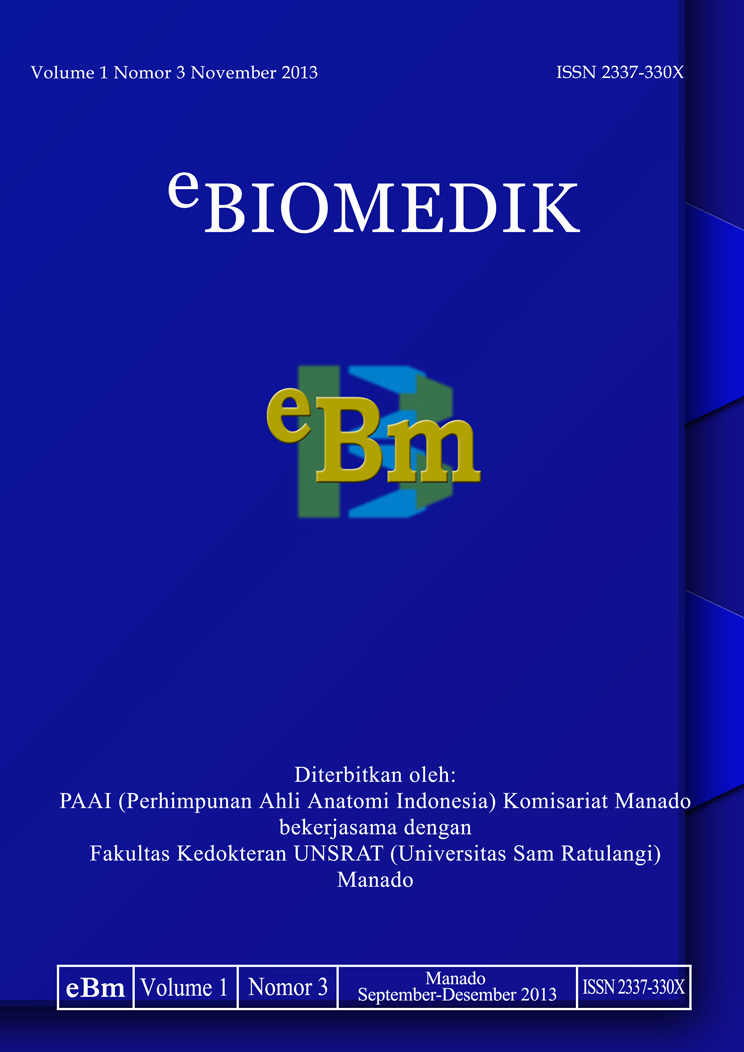GAMBARAN HISTOPATOLOGI HATI TIKUS WISTAR YANG DIBERIKAN JUS TOMAT (Solanum Lycopersicum) PASCA KERUSAKAN HATI WISTAR YANG DIINDUKSI KARBON TETRAKLORIDA (CCl4)
DOI:
https://doi.org/10.35790/ebm.v1i3.3583Abstract
Abstract: Liver is the largest organ in the abdominal cavity. As the center of metabolism in the body, liver is potentially damaged by exposure of toxic substances, inter alia carbon tetrachloride (CCl4). Metabolism of carbon tetrachloride (CCl4) produces CCl3 free radicals that can damage the liver. In Indonesia, there are a lot of natural ingredients that have antioxidant properties, such as tomato. Lycopene in tomatoes contains antioxidant compounds that can prevent damages due to free radical. This study aimed to obtain liver histopathological changes of wistar rats fed with tomato juice after being induced of carbon tetrachloride (CCl4). This was an experimental study, using 10 wistar rats which were divided into 4 groups. Group I was the negative control; group II was induced with CCl4 0,05 cc/day and was terminated on day 6; group III was induced with CCl4 0,05 cc/day and was given tomato juice 3 ml/day, and terminated on day 13; group IV was induced by CCl4 0,05 cc/day, given regular pellets, and terminated on day 13. The results showed that group II had histopathological changes of the liver indicating fatty liver, meanwhile group III showed regeneration of nearly all liver cells. Conclusion: Administration of tomato juice after the induction of 3 ml carbon tetrachloride (CCl4) for 7 day showed regeneration of almost all liver cells.
Keywords: histopathological changes of the liver, carbon tetrachloride, tomato juice.
Â
Â
Abstrak: Hati merupakan organ terbesar dalam rongga abdomen, dan pusat metabolisme tubuh dengan fungsi yang sangat kompleks dan sangat berpotensi mengalami kerusakan akibat terpapar oleh bahan-bahan toksik, salah satunya yaitu karbon tertraklorida (CCL4). Metabolisme CCl4 menghasilkan radikal bebas CCl3 yang dapat merusak hati. Di Indonesia terdapat  banyak sekali bahan-bahan alami yang mempunyai kandungan antioksidan, salah satunya yaitu tomat. Tomat mengandung senyawa likopen sebagai antioksidan yang dapat mencegah kerusakan jaringan akibat radikal bebas. Penelitian ini bertujuan untuk mendapatkan gambaran histopatologi hati tikus wistar yang diberi jus tomat pasca induksi karbon tetraklorida (CCl4). Metode penelitian ialah eksperimental. Sampel sebanyak 10 ekor tikus wistar yang dibagi dalam 4 kelompok. Kelompok I sebagai kontrol negatif; kelompok II diinduksi CCl4 0,05cc/perhari dan diterminasi hari ke-6; kelompok III diinduksi CCl4 0,05 cc/hari kemudian diberikan jus tomat 3ml/hari;  dan kelompok IV diinduksi CCl4 0,05 cc/hari kemudian diberikan pelet biasa dan diterminasi hari ke-13. Hasil penelitian menunjukkan pada pemberian CCl4 pada tikus wistar selama 5 hari terdapat gambaran morfologik perlemakan sel hati. Pemberian jus tomat dosis 3 ml pasca induksi karbon tetraklorida (CCl4) menunjukkan terjadinya regenerasi pada hampir seluruh sel-sel hati. Simpulan: Pemberian jus tomat dosis 3 ml pasca induksi karbon tetraklorida (CCl4) selama 7 hari menunjukkan regenerasi pada hampir seluruh sel-sel hati.
Kata kunci: gambaran histopatologi hati, karbon tetraklorida, jus tomat.





